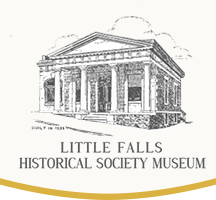This Week in History – Week of Jan. 30th

Jan. 30th
1868
The Central Railroad Night Express train met with an accident a few miles east of Little Falls. A broken rail threw three of the passenger coaches from the track. All the passengers escaped without injury.
1900
Miss Petrie’s class in physical culture played a basketball game against Herkimer with Little Falls winning 24 to 14. Seventy-five Ladies were present for the game, after which Gentlemen were admitted for dancing. Susan B. Anthony’s and Dr. Anna Shaw’s speeches were not falling on deaf ears.
1906
In what is normally the coldest part of the winter, the mercury in Little Falls reached 71F. Doors and windows were open, people sat out on porches, overcoats were on men’s arms, and the sprinkler wagon was out to water down the dusty streets.
Feb. 1st
1892
The first electric lights were turned on at 7:46 PM, “illumed the streets of the village”, with the Electric Committee having the honor of throwing the switch. The Thompson-Houston system has 83 lights with several more to be added. Little Falls’ citizens were highly pleased. Mill whistles and church bells heralded the occasion.
1893
An early morning disastrous blaze destroyed two hotels, including the Hinchman House, and ten businesses in the heart of the city. The fire originated in a big new barn fronting on Albany Street, and it took the assistance of local and area firefighters, and those from Herkimer and Utica, brought to Little Falls by a special train, to tame the fire.
1901
The scale of wages agreed upon by contractors and painters of this city for the coming season is $2.50 for nine hours work. Heretofore it had been $2.50 for ten hours work.
1952
The Grange store on South Second Street in Little Falls was closing after 60 years in operation. The newly remodeled Gray’s Super Market on East John Street, Little Falls, was set for its formal opening. Ignatz Gray began the business in 1918. The store had been known as Red Star Market or the WGY Food Store.
Feb. 2nd
1887
Machinery for making knitting needles is in place at M. Reddy’s works on the south side. About a dozen employees of both sexes are engaged in this intricate and interesting business.
Feb. 4th
1794
The grounds were cleared and work was started on the Octagon Church. also known as the “Pepper Box.” It was completed in 1818 and torn down in 1842. The church was to be 60 feet in major diameter, having a sloped roof leading to a cupola topped with hollow gilt balls. Papers were placed inside the balls that were normally placed in a cornerstone. The church would have a capacity for 300 people.
1900
The Christ Evangelical Lutheran church was organized by the vision of local residents of German extraction. Initial preaching and teaching was in the German language, but the congregation soon introduced services in English.
Feb. 5th
1892
The toboggan slide of East Monroe Street is now completed and ready for business every afternoon and evening when the weather is cold enough to freeze water. The slide is a safe and exhilarating sport and provides a run of about one quarter mile.
1902
A bitter debate ensued a the council meeting when it was learned that Mayor Kingsbury purchased horses for the fire department without consulting his colleagues on the horse-buying committee. The horses were “rejected” but not returned and continued to eat at $2.25 per day per horse. A long time passed before the horses were finally returned to Utica.
This Week in History” is brought to you by the Little Falls Historical Society. Please Visit the Little Falls Historical Society Website and please consider supporting the Museum by becoming a Member. Download the membership form here!
Additional Links
- Little Falls Historical Society
- Times Telegram
- Little Falls, NY
- Little Falls City School District
- Little Falls Hospital
- City of Little Falls
- Little Falls Youth & Family Center
- Mohawk Valley Center for the Arts
- Upstate Venture Connect
- Shop Little Falls, NY
- Preserve Our Past
- The Mohawk Valley Through the Lens
- My Little Falls
- Think Local Little Falls
- Little Falls Public Library
